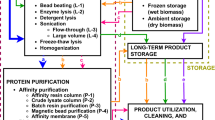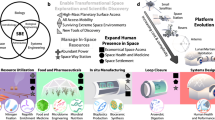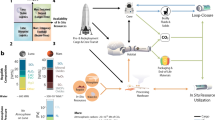Abstract
Investment in spacefaring enterprises must offer transformative solutions to Earth-based challenges. Providing for the future health of our home planet is possibly the greatest return on investment. Therefore, ensuring that the large costs of astronautics also yield benefits on Earth is critical. The goal of space bioprocess engineering is the design, realization and management of biologically driven technologies for supporting off-world human exploration. Here, we outline several technologies with high dual-use potential, argue that continued investment in such technologies is justified, and offer insight into specific research and development strategies that will increase sociological, political and technological benefits for sustainable development on Earth.
This is a preview of subscription content, access via your institution
Access options
Access Nature and 54 other Nature Portfolio journals
Get Nature+, our best-value online-access subscription
$29.99 / 30 days
cancel any time
Subscribe to this journal
Receive 12 digital issues and online access to articles
$119.00 per year
only $9.92 per issue
Buy this article
- Purchase on Springer Link
- Instant access to full article PDF
Prices may be subject to local taxes which are calculated during checkout
Similar content being viewed by others
References
Scott-Heron, G. Small Talk at 125th and Lenox (Flying Dutchman/RCA Records, 1970).
Smith, M. et al. The Artemis program: an overview of NASA’s activities to return humans to the Moon. In Proc. 2020 IEEE Aerospace Conference 1–10 (IEEE, 2020); https://ieeexplore.ieee.org/document/9172323
Loyd, J. M. in Mobile Desires: The Politics and Erotics of Mobility Justice (eds Montegary, L. & White, M. A.) 41–52 (Springer, 2015); https://doi.org/10.1057/9781137464217_4%0A%0A
Maher, N. M. Grounding the space race. Mod. Am. Hist. 1, 141–146 (2018).
Free, J. M. & Roe, R. NASA’s Management of the Artemis Missions Techical Report IG-22-003 (National Aeronautics and Space Administration, 2021); https://oig.nasa.gov/docs/IG-22-003.pdf
Jones, H. Humans to Mars will cost about “half a trillion dollars" and life support roughly two billion dollars. In Proc. 46th International Conference on Environmental Systems Paper ICES-2016-111 (International Conference on Environmental Systems, 2016); https://ttu-ir.tdl.org/handle/2346/67531
Hertzfeld, H. R. Measuring the economic returns from successful NASA life sciences technology transfers. J. Technol. Transf. 27, 311–320 (2002).
Autry, G. America’s investment in space pays dividends. Forbes https://www.forbes.com/sites/gregautry/2017/07/09/americas-investment-in-space-pays-dividends/ (2017).
Returns and Benefits from Public Space Investments 2021 (UK Space Agency, 2022); https://www.gov.uk/government/publications/returns-and-benefits-from-public-space-investments-2021
Berliner, A. J. et al. Space bioprocess engineering on the horizon. Commun. Eng. 1, 13 (2022).
Talbert, T. & Green, M. Space Technology Grand Challenges (National Aeronautics and Space Administration, 2010).
Ekins, P. & Zenghelis, D. The costs and benefits of environmental sustainability. Sustain. Sci. 16, 949–965 (2021).
Söderholm, P. The green economy transition: the challenges of technological change for sustainability. Sustain. Earth Rev. 3, 6 (2020).
Renault, M. Mars mission could bring health benefits on Earth. Nat. Med. 28, 216–218 (2022).
Averesch, N. J. H. et al. Microbial biomanufacturing for space-exploration—what to take and when to make. Nat. Commun. 14, 2311 (2023).
Santomartino, R. et al. Toward sustainable space exploration: a roadmap for harnessing the power of microorganisms. Nat. Commun. 14, 1391 (2023).
Thriving in Space: Ensuring the Future of Biological and Physical Sciences Research: A Decadal Survey for 2023–2032 (National Academies Press, 2023); https://nap.nationalacademies.org/catalog/26750/thriving-in-space-ensuring-the-future-of-biological-and-physical-sciences-research-a-decadal-survey-for-2023-2032
Lockney, D. (ed.) NASA Spinoff https://spinoff.nasa.gov/ (2022).
Earle, K. D. et al. Strategic framework for NASA’s Space Technology Mission Directorate. In Proc. 2018 AIAA SPACE and Astronautics Forum and Exposition AIEE 2018-5136 (American Institute of Aeronautics and Astronautics, 2018); https://arc.aiaa.org/doi/abs/10.2514/6.2018-5136
Sanders, G. B. & Kleinhenz, J. E. NASA envisioned future priorities for in situ resource utilization. In Proc. 73rd International Astronautical Congress (IAC) (International Astronautical Federation, 2022); https://ntrs.nasa.gov/citations/20220012448
Moroni, L. et al. What can biofabrication do for space and what can space do for biofabrication? Trends Biotechnol. 40, 398–411 (2022).
Bar-Even, A. Daring metabolic designs for enhanced plant carbon fixation. Plant Sci. 273, 71–83 (2018).
DeLisi, C. et al. The role of synthetic biology in atmospheric greenhouse gas reduction: prospects and challenges. Biodes. Res. 2020, 1016207 (2020).
Ghidini, T. Regenerative medicine and 3D bioprinting for human space exploration and planet colonisation. J. Thorac. Dis. 10, S2363–S2375 (2018).
Walker, J. & Granjou, C. MELiSSA the minimal biosphere: human life, waste and refuge in deep space. Futures 92, 59–69 (2017).
Niederwieser, T., Kociolek, P. & Klaus, D. Spacecraft cabin environment effects on the growth and behavior of Chlorella vulgaris for life support applications. Life Sci. Space Res. 16, 8–17 (2018).
McNulty, M. J. et al. Molecular pharming to support human life on the Moon, Mars, and beyond. Crit. Rev. Biotechnol. 41, 849–864 (2021).
Mortimer, J. C. & Gilliham, M. SpaceHort: redesigning plants to support space exploration and on-Earth sustainability. Curr. Opin. Biotechnol. 73, 246–252 (2022).
Nosseir, A. E. S., Cervone, A. & Pasini, A. Modular impulsive green monopropellant propulsion system (MIMPS-G): for CubeSats in LEO and to the Moon. Aerospace 8, 169 (2021).
Cruz-Morales, P. et al. Biosynthesis of polycyclopropanated high energy biofuels. Joule 6, 1590–1605 (2022).
Abel, A. J. et al. Photovoltaics-driven power production can support human exploration on Mars. Front. Astron. Space Sci. 9, 868519 (2022).
Grossi, E. N. et al. Potential applications for bioelectrochemical systems for space exploration. In Proc. 43rd International Conference on Environmental Systems AIAA 2013-3331 (American Institute of Aeronautics and Astronautics, 2013); https://arc.aiaa.org/doi/10.2514/6.2013-3331
Averesch, N. J. H. & Rothschild, L. J. Metabolic engineering of Bacillus subtilis for production of para-aminobenzoic acid – unexpected importance of carbon source is an advantage for space application. Microb. Biotechnol. 12, 703–714 (2019).
Cestellos-Blanco, S. et al. Production of PHB from CO2-derived acetate with minimal processing assessed for space biomanufacturing. Front. Microbiol. 12, 700010 (2021).
Urbina, J. et al. A new approach to biomining: bioengineering surfaces for metal recovery from aqueous solutions. Sci. Rep. 9, 16422 (2019).
Cockell, C. S. et al. Space station biomining experiment demonstrates rare earth element extraction in microgravity and Mars gravity. Nat. Commun. 11, 5523 (2020).
Clomburg, J. M., Crumbley, A. M. & Gonzalez, R. Industrial biomanufacturing: the future of chemical production. Science 355, aag0804 (2017).
Szocik, K. & Reiss, M. J. Why space exploitation may provide sustainable development: climate ethics and the human future as a multi-planetary species. Futures 147, 103110 (2023).
Maiwald, V., Schubert, D., Quantius, D. & Zabel, P. From space back to Earth: supporting sustainable development with spaceflight technologies. Sustain. Earth 4, 3 (2021).
Maiwald, V. Frameworks of sustainability and sustainable development in a spaceflight context: a systematic review and critical analysis. Acta Astronaut. https://doi.org/10.1016/j.actaastro.2023.01.023 (2023).
Colglazier, W. Sustainable development agenda: 2030. Science 349, 1048–1050 (2015).
Lee, B. X. et al. Transforming our world: implementing the 2030 agenda through Sustainable Development Goal Indicators. J. Public Health Policy 37, 13–31 (2016).
Lu, Y., Nakicenovic, N., Visbeck, M. & Stevance, A.-S. Policy: five priorities for the UN Sustainable Development Goals. Nature 520, 432–433 (2015).
Maibach, E. W., Nisbet, M., Baldwin, P., Akerlof, K. & Diao, G. Reframing climate change as a public health issue: an exploratory study of public reactions. BMC Public Health 10, 299 (2010).
Agarwal, A. & Narain, S. in India in a Warming World: Integrating Climate Change and Development (ed. Dubash, N. K.) 81–91 (Oxford Univ. Press, 2019); https://doi.org/10.1093/oso/9780199498734.003.0005
Murad, S. et al. Molecular pharming for low and middle income countries. Curr. Opin. Biotechnol. 61, 53–59 (2020).
Bentahir, M., Barry, M. D., Koulemou, K. & Gala, J.-L. Providing on-site laboratory and biosafety just-in-time training inside a box-based laboratory during the West Africa Ebola outbreak: supporting better preparedness for future health emergencies. Int. J. Environ. Res. Public Health 19, 11566 (2022).
Weisbin, C. R. et al. Capability development return on investment for the NASA aeronautics program. In Proc. 18th International Conference on Systems Engineering (ICSEng’05) 231–237 (IEEE, 2005); https://doi.org/10.1109/ICSENG.2005.21
Berger, E. Report finds that US accounts for more than half of global space spending. Ars Technica https://arstechnica.com/science/2022/01/report-finds-that-us-accounts-for-more-than-half-of-global-space-spending/ (2022).
Tollefson, J. IPCC says limiting global warming to 1.5 °C will require drastic action. Nature 562, 172–174 (2018).
United Nations Department of Economic and Social Affairs World Population Prospects 2022: Data Sources Report UN DESA/POP/2022/DC/NO. 9 (United Nations, 2022); https://population.un.org/wpp/Publications/Files/WPP2022_Data_Sources.pdf
Joint Statement of Janet L. Yellen, Secretary of the Treasury, and Shalanda D. Young, Director of the Office of Management and Budget, on budget results for fiscal year 2023. US Department of the Treasury https://home.treasury.gov/news/press-releases/jy1829 (2023).
Budget of the U.S. Government: Fiscal Year 2023 (Office of Management and Budget, 2022); https://www.whitehouse.gov/wp-content/uploads/2022/03/budget_fy2023.pdf
Rhodes, R. E., Henderson, E. M. & Robinson, J. W. Choices for long term sustainable space exploration and habitation with recommended near term focus. In Proc. 50th AIAA/ASME/SAE/ASEE Joint Propulsion Conference, AIAA 2014-3648 (American Institute of Aeronautics and Astronautics, 2014).
Boden, T., Andres, R. & Marland, G. Global, Regional, and National Fossil-Fuel CO2 Emissions (1751 - 2014) (V. 2017) (Office of Scientific and Technical Information, 2017); https://www.osti.gov/servlets/purl/1389331/
Nakahodo, S. N. & Gonzalez, S. Creating startups with NASA technology. New Space 8, 137–145 (2020).
Griffin, M. D. The Space Economy (National Aeronautics and Space Administration, 2007); https://www.i-mti.com/NASA_SE_20070917_ExcerptHiL.pdf
Globus, A. Sourcing and Sustaining Optimum Financing (National Space Society, 2018); https://space.nss.org/settlement/nasa/spaceresvol4/references.html
Der, V. K. Clean Coal Technology Programs: Program Update 2009 (US Department of Energy, 2009); https://www.osti.gov/biblio/970830
Lozano, R., Carpenter, A. & Huisingh, D. A review of ‘theories of the firm’ and their contributions to corporate sustainability. J. Clean. Prod. 106, 430–442 (2015).
Dyllick, T. & Hockerts, K. Beyond the business case for corporate sustainability. Bus. Strategy Environ. 11, 130–141 (2002).
Crawford, I. A. Lunar resources: a review. Prog. Phys. Geogr. 39, 137–167 (2015).
Sharma, A. et al. Biomanufacturing in low Earth orbit for regenerative medicine. Stem Cell Rep. 17, 1–13 (2022).
Romero, E. & Francisco, D. The NASA human system risk mitigation process for space exploration. Acta Astronaut. 175, 606–615 (2020).
Apul, O., Grissom, R., Damali, U. & Toof, R. Divided perception of drinking water safety: another manifestation of America’s racial gap. ACS EST Water 1, 6–7 (2021).
Batelaan, K. ‘It’s not the science we distrust; it’s the scientists’: reframing the anti-vaccination movement within Black communities. Glob. Public Health 17, 1099–1112 (2022).
Global Sustainable Development Report 2019: The Future is Now – Science for Achieving Sustainable Development (United Nations, 2019); https://sustainabledevelopment.un.org/content/documents/24797GSDR_report_2019.pdf
Hernandez-Aguilera, J. N. et al. Supporting interdisciplinary careers for sustainability. Nat. Sustain. 4, 374–375 (2021).
Roy, J. R. in Engineering and Engineering Technology by the Numbers, 2019 1–40 (American Society for Engineering Education, 2020).
Technology Drives Exploration (National Aeronautics and Space Administration, 2014); https://www.nasa.gov/sites/default/files/atoms/files/stmd_technology_drives_exploration_508_8_11_2016.pdf
Sheldon, R. A. The E factor 25 years on: the rise of green chemistry and sustainability. Green. Chem. 19, 18–43 (2017).
Sheldon, R. A. Metrics of green chemistry and sustainability: past, present, and future. ACS Sustain. Chem. Eng. 6, 32–48 (2018).
Fiorentino, G., Ripa, M. & Ulgiati, S. Chemicals from biomass: technological versus environmental feasibility. A review. Biofuel. Bioprod. Biorefin. 11, 195–214 (2017).
Clauser, N. M. et al. Biomass waste as sustainable raw material for energy and fuels. Sustainability 13, 794 (2021).
Mankins, J. C. Technology readiness assessments: a retrospective. Acta Astronaut. 65, 1216–1223 (2009).
Frerking, M. A. & Beauchamp, P. M. JPL technology readiness assessment guideline. In Proc. 2016 IEEE Aerospace Conference 1–10 (IEEE, 2016); https://doi.org/10.1109/AERO.2016.7500924
Smanski, M. J. et al. Bioindustrial manufacturing readiness levels (BioMRLs) as a shared framework for measuring and communicating the maturity of bioproduct manufacturing processes. J. Ind. Microbiol. Biotechnol. 49, kuac022 (2022).
Schlosberg, D. & Collins, L. B. From environmental to climate justice: climate change and the discourse of environmental justice. WIREs Clim. Change 5, 359–374 (2014).
Dietz, T., Shwom, R. L. & Whitley, C. T. Climate change and society. Annu. Rev. Sociol. 46, 135–158 (2020).
NASA Strategic Space Technology Investment Plan 2017 (National Aeronautics and Space Administration, 2017); https://www.nasa.gov/sites/default/files/atoms/files/2017-8-1_stip_final-508ed.pdf
Sadler, P. et al. Bio-regenerative life support systems for space surface applications. In Proc. 41st International Conference on Environmental Systems AIAA 2011-5133 (American Institute of Aeronautics and Astronautics, 2011); https://doi.org/10.2514/6.2011-5133
Giacomelli, G. et al. Bio-regenerative life support system development for lunar/Mars habitats. In Proc. 42nd International Conference on Environmental Systems AIAA 2012-3463 (American Institute of Aeronautics and Astronautics, 2012); https://doi.org/10.2514/6.2012-3463
Rai, I., Ahirwar, A., Rai, A., Varjani, S. & Vinayak, V. Biowaste recycling strategies for regenerative life support system: an overview. Sustain. Energy Technol. Assess. 53, 102525 (2022).
Gòdia, F. et al. MELISSA: a loop of interconnected bioreactors to develop life support in space. J. Biotechnol. 99, 319–330 (2002).
Vermeulen, A. C. J., Papic, A., Nikolic, I. & Brazier, F. Stoichiometric model of a fully closed bioregenerative life support system for autonomous long-duration space missions. Front. Astron. Space Sci. 10, 1198689 (2023).
Ilgrande, C. et al. Reactivation of microbial strains and synthetic communities after a spaceflight to the International Space Station: corroborating the feasibility of essential conversions in the MELiSSA loop. Astrobiology 19, 1167–1176 (2019).
Garcia-Gragera, D. et al. Integration of nitrifying, photosynthetic and animal compartments at the MELiSSA Pilot Plant. Front. Astron. Space Sci. 8, 750616 (2021).
Zabel, P. et al. Introducing EDEN ISS – a European project on advancing plant cultivation technologies and operations. Zenodo https://zenodo.org/record/34391 (2015).
Zabel, P., Vrakking, V., Zeidler, C. & Schubert, D. Energy and power demand of food production in space based on results of the EDEN ISS Antarctic greenhouse. In Proc. 51st International Conference on Environmental Systems Paper ICES-2022-87 (International Conference on Environmental Systems, 2022); https://ttu-ir.tdl.org/handle/2346/89625
Pattison, P. M., Tsao, J. Y., Brainard, G. C. & Bugbee, B. LEDs for photons, physiology and food. Nature 563, 493–500 (2018).
Soundararajan, M. et al. Phototrophic N2 and CO2 fixation using a Rhodopseudomonas palustris-H2 mediated electrochemical system with infrared photons. Front. Microbiol. 10, 1817 (2019).
Cestellos-Blanco, S., Zhang, H. & Yang, P. Solar-driven carbon dioxide fixation using photosynthetic semiconductor bio-hybrids. Faraday Discuss. 215, 54–65 (2019).
Santomartino, R., Zea, L. & Cockell, C. S. The smallest space miners: principles of space biomining. Extremophiles 26, 7 (2022).
French, K. E. Harnessing synthetic biology for sustainable development. Nat. Sustain. 2, 250–252 (2019).
Taherzadeh, M. J. Bioengineering to tackle environmental challenges, climate changes and resource recovery. Bioengineered 10, 698–699 (2019).
Honan, M., Feng, X., Tricarico, J. M. & Kebreab, E. Feed additives as a strategic approach to reduce enteric methane production in cattle: modes of action, effectiveness and safety. Anim. Prod. Sci. https://doi.org/10.1071/AN20295 (2021).
Jansson, C. et al. Crops for carbon farming. Front. Plant Sci. 12, 636709 (2021).
Solé, R. Bioengineering the biosphere? Ecol. Complex. 22, 40–49 (2015).
Acknowledgements
This work was supported by NASA under award numbers NNX17AJ31G and 80NSSC22K1474. Any conclusions, recommendations, or opinions expressed in this material are those of the authors and do not necessarily reflect the views of NASA. The content of this publication has not been approved by the United Nations and does not reflect the views of the United Nations or its officials or Member States. We thank D. Ho for graphics used in Table 1. Furthermore, we thank J. King, D. Hall, S. N. Nangle, B. Biggs, J. A. Hogan and A. J. Abel for their constructive comments on early drafts of this manuscript. We thank Professor A. P. Arkin for his continued patience in reviewing and re-reviewing the manuscript and for his watchful eye over our efforts.
Author information
Authors and Affiliations
Contributions
All authors (G.V., I.L., G.A.H., N.J.H.A. and A.J.B.) developed, wrote and edited the manuscript, led by A.J.B.
Corresponding authors
Ethics declarations
Competing interests
The authors declare no competing interests.
Peer review
Peer review information
Nature Sustainability thanks Volker Maiwald, Rosa Santomartino and Mamta Patel Nagaraja for their contribution to the peer review of this work.
Additional information
Publisher’s note Springer Nature remains neutral with regard to jurisdictional claims in published maps and institutional affiliations.
Supplementary information
Supplementary Information
Supplementary Discussion (describing examples of technologies with aspects of SBE), Tables 1 and 2 and refs. 1–58.
Rights and permissions
Springer Nature or its licensor (e.g. a society or other partner) holds exclusive rights to this article under a publishing agreement with the author(s) or other rightsholder(s); author self-archiving of the accepted manuscript version of this article is solely governed by the terms of such publishing agreement and applicable law.
About this article
Cite this article
Vengerova, G., Lipsky, I., Hutchinson, G.A. et al. Space bioprocess engineering as a potential catalyst for sustainability. Nat Sustain 7, 238–246 (2024). https://doi.org/10.1038/s41893-024-01305-x
Received:
Accepted:
Published:
Issue Date:
DOI: https://doi.org/10.1038/s41893-024-01305-x



